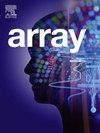AggreGait: Automatic gait feature extraction for human age and gender classification with possible occlusion
IF 2.3
Q2 COMPUTER SCIENCE, THEORY & METHODS
引用次数: 0
Abstract
The growing interest in smart surveillance and automated public access control necessitates robust age and gender classification (AGC) techniques that can operate effectively in unconstrained environments. While model-based gait obtained via pose estimation offers a promising approach, its performance can be hindered by occlusions commonly encountered in real-world videos. In this work, we propose a custom Graph Neural Network (GNN) architecture, AggreGait, for robust AGC under occlusions. AggreGait integrates upper and lower body features with whole-body information for age and gender prediction. We train AggreGait on pose sequences from the gait-in-the-wild (GITW) dataset, simulating different types of occlusions. AggreGait performs comparably to existing methods, achieving an overall accuracy of 91% in unobstructed conditions. Notably, AggreGait maintains reasonable accuracy using only upper limb (or upper and lower limb) features, suggesting its potential for real-time surveillance applications despite occlusions. This work paves the way for practical gait-based AGC in unconstrained environments, enhancing the effectiveness of surveillance systems and facilitating automated access control.

AggreGait:自动步态特征提取,用于可能闭塞的人类年龄和性别分类
对智能监控和自动化公共访问控制日益增长的兴趣需要强大的年龄和性别分类(AGC)技术,这些技术可以在不受约束的环境中有效运行。虽然通过姿态估计获得的基于模型的步态提供了一种很有前途的方法,但它的性能可能会受到现实世界视频中常见的遮挡的阻碍。在这项工作中,我们提出了一个自定义的图神经网络(GNN)架构AggreGait,用于遮挡下的鲁棒AGC。AggreGait将上半身和下半身的特征与全身信息相结合,用于预测年龄和性别。我们在来自野外步态(GITW)数据集的姿态序列上训练aggre步态,模拟不同类型的遮挡。AggreGait的性能与现有方法相当,在无障碍条件下的总体准确率达到91%。值得注意的是,AggreGait仅使用上肢(或上肢和下肢)特征就能保持合理的准确性,这表明它具有在闭塞情况下进行实时监测的潜力。这项工作为在无约束环境中实现基于步态的AGC铺平了道路,提高了监视系统的有效性,并促进了自动访问控制。
本文章由计算机程序翻译,如有差异,请以英文原文为准。
求助全文
约1分钟内获得全文
求助全文

 求助内容:
求助内容: 应助结果提醒方式:
应助结果提醒方式:


